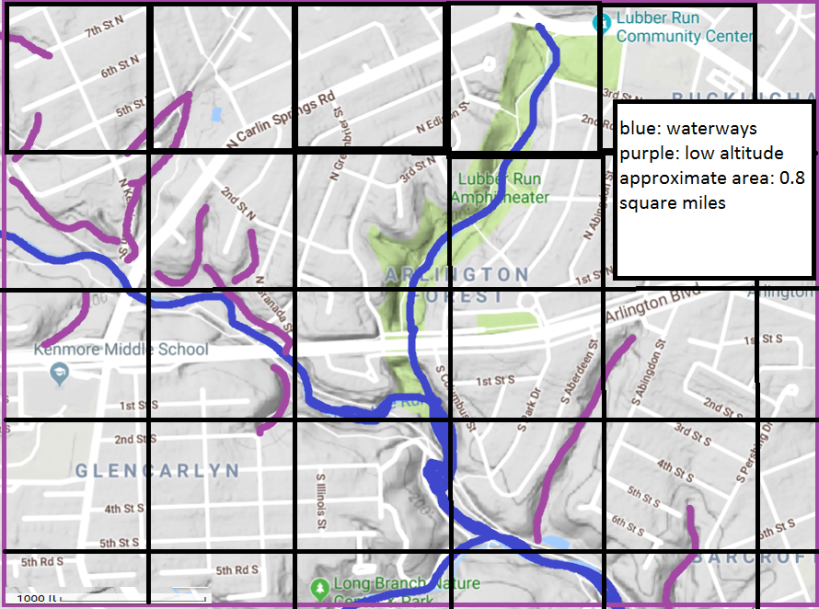One of the most critical issues facing Arlington’s watershed is the County’s high concentration of impervious surfaces, in combination with its lack of stormwater controls.
According to the County’s Environmental Department , 42% of Arlington’s surface area is impervious. These non-porous areas (including parking lots, roads, sidewalks and buildings) transport water instead of absorbing it like natural landscapes (meadows, forests, etc.) can. This would create interesting technical challenges for even the most environmentally consciously constructed localities. Alas, Arlington is a little behind the times in this department.
The County’s webpage on Streams explains that most structures in the locality were built before many stormwater regulations were established. As a result, the County lacks the infrastructure to slow down or treat stormwater before it flows into waterways, harming stream health.
Why Treat Stormwater?
It’s valuable to treat stormwater to prevent pollutants from entering the watershed. When it rains, water collects debris and pollutants and shuffles them into local streams. These hazards may include fertilizers and pesticides from homeowners’ yards, oil from cars, pet waste, cigarette butts, plastic, trash, and more (Waters, Poe & Wagner, 2011).
These pollutants damage the local environment by harming fish and plant health (Waters, Poe & Wagner, 2011). Humans recreating in or eating fish collected from contaminated waters may suffer health effects as well (Waters, Poe & Wagner, 2011).
Effects of Untreated Stormwater
With Arlington’s high incidence of impervious surfaces and outdated stormwater infrastructure, it is no surprise that the county suffers ill effects. The County Stormwater webpage lists its top concerns for the region:
-High volume of water entering streams during storm events, causing erosion to stream banks, trails, and trees
-Pollutants impacting water quality (as described above). The County explains that though the water quality in Arlington streams is generally “fair,” bacteria levels in some areas like Four Mile Run routinely exceed safe standards for human recreation.
-Hot surfaces increase water temperature harming aquatic life
-Lack of groundwater recharging, to sustain water levels during dry periods
The County’s Streams webpage also mentions that the county is at risk for flash flooding. Locals will recall that just recently motorists had to be rescued from their cars when the GW Parkway experienced a rapid water level increase. For more information, check out the Washington Post’s coverage of the incident.
Solutions to the Issue?
Improving stormwater infrastructure is one approach, though it would be an expensive retrofit. In light of Arlington’s increasingly tight budget, this construction seems infeasible in the near future.
Local non-profit Eco-Action Arlington (which will be explored in more detail in an upcoming post) addresses the problem with volunteers. This organization regularly coordinates stream clean ups to collect trash before it floats into the watershed. These efforts not only help prevent pollutants from contaminating the streams, but also serve as important educational events for residents.
Still, smaller particulates like oil and fertilizers cannot be manually captured by volunteers. Educational efforts to encourage landowners to use chemicals sparingly and to clean up oil and pet waste may reduce these contaminants’ presence.
Sources:
Stormwater & Watersheds. Arlington County website. Retrieved from https://environment.arlingtonva.us/stormwater-watersheds/
Streams. Arlington County website. Retrieved from https://environment.arlingtonva.us/streams/
Waters, S., Farrell-Poe, K., Wagner, K. (2011). When it Rains it Runs Off: Runoff and Urbanized Areas in Arizona. University of Arizona Extension.
